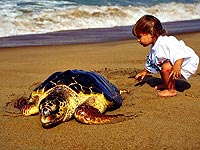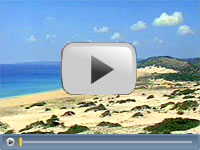
North Cyprus Turtle Watching.
 |
the north cyprus travel guide |
 |
|
Turtle Watching in North Cyprus
The sight of newly-hatched sea turtles scrabbling out of their sandy nest chambers on North Cyprus beaches and scuttling towards to the open sea is a joy to watch. Their mothers have swum in the warm Mediterranean sea for twenty years before mating. One moonlit might, they will come ashore to lay their eggs. The females come ashore in May and dig deep pits into which they lay their eggs, about 40 cm down, before carefully covering them with literally tonnes of sand. Then they swim away, leaving the eggs safe and cool in their sandy nest, the sand around the eggs trapping air, which is vital to their development. Female green turtles can make several nests during a season, each containing a batch of eggs laid two weeks apart. Read the blog titled "Time for Turtles in North Cyprus" North Cyprus Turtles Forum Board
Hatching Sea Turtles in CyprusTwo months later, in July, the leathery eggs hatch and the tiny baby turtles head upwards into the open air. They frantically dig their way to the surface, emerging either in the cool of dawn or early evening, before scuttling out into the sea. Or that’s the theory, anyway. For a newly-hatched sea turtle, their first instinct is head towards the light. For thousands of years this has meant the light from the sea, glowing gently in the moonlight, but with modern waterside developments, they can head the wrong way with disastrous results. In south Cyprus, modern developments have driven the turtles from all but a few of their nesting sites, but the quieter bays of Northern Cyprus and the Turkish coastline provide breeding sanctuaries for the 300 green turtles and thousand loggerhead turtles that live in the Mediterranean. Turtle nesting sites in North CyprusTurtles still nest on sandy beaches around Girne (Kyrenia), on the Karpaz peninsula and in Famagusta Bay. Both green and loggerhead turtles are listed as endangered species and are heavily protected. SPOT also works with teams from various British universities to survey nesting sites and release youngsters safely into the sea. Turtle Watching on Alagadi BeachYou can watch the turtles under the supervision of the Society for the Protection of Turtles (SPOT) Turtle HQ, based at Alagadi Turtle Beach. This is by far the best way to both see and help the turtles, as even visiting nesting beaches during the breeding season can seriously affect the turtles’ welfare. The research team at Alagadi beach conduct both night and dawn beach surveys to check on hatching activity, and you can join them on their night patrols. Full details of all SPOT’s work and activities are on display at the beachside information centre. Turtle Protection in Northern Cyprus In an effort to protect the turtles, the Department of Environmental Protection has imposed measures between May to October that forbids access to a beach between 10pm and 8am, forbids fires or lights on the beach and use of a speedboat within one mile of the shoreline. The protection measures also advise people not to throw plastic bags into the sea; the turtles mistake them for jellyfish and die from trying to eat them. You can even track the turtles via the internet, at http://www.seaturtle.org/tracking/ Help with Turtle Conservation in North CyprusYou can also volunteer to help the researchers, but be advised this is a commitment of 6-8 weeks, and involves sleeping on a camp bed and walking up to 20km a day! Full details at http://www.seaturtle.org/mtrg/projects/cyprus/volunteer/ |
|
|||||||||||||||||||||||||||||||||||||||||||||||||||||||||||||||||||
North Cyprus quick: holidays | flights | hotels | property | kyrenia | famagusta | photos | map | weather | history | news
All text is copyrighted by Cyprus44. Photographs are copyrighted by their respective photographers.
For more information read our copyright policy, privacy policy and disclaimer.
This web page is served on 13 September 2025 at 7:11:19 PM.
![]()
Cyprus44 in other languages: Nordzypern | Chypre Nord | Severní Kypr | Северный Кипр
partner sites: goNorthCyprus Travel | Pacific Rent-A-Car | Amy Holiday Villas | other partner sites









